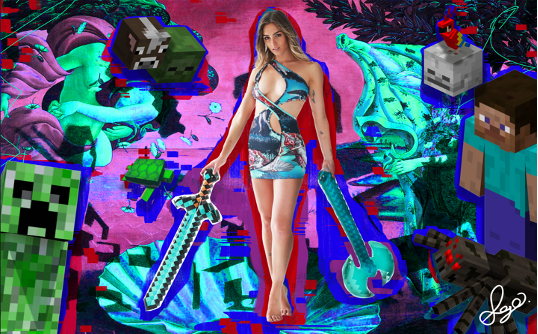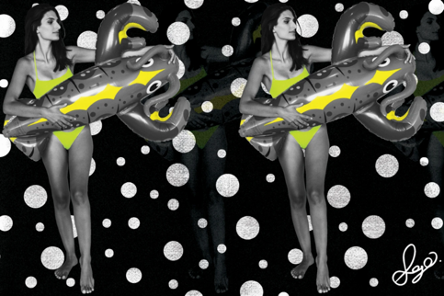Paris-based artist Sean Go spins iconic works by Botticelli, Koons and Klimt into surreal pop art
Sean Go is an artist on the rise...
By Jon Stojan

Appropriation – a term both loved and hated, often finds itself in the center of the discourse of what defines “good” art. Sean Go, an appropriation artist, is one of the most exciting artists to come out of Asia today because of his playful banter with grandmasters and artists of the past. However, in his dialogue with past artists, sometimes his works deface those of the past and the implied meanings behind historical art. Many of Go’s works are aspirational, vibrant, and sharp in critiquing today’s society, which is driven so much by optics, envy, and false narratives. For Go, it is important to use symbols, allusions, and visual alliteration to communicate ideas and beliefs that humans as a species seem to cherish, dispute, and find meaning in. Go has been featured in numerous art shows in Indonesia, the Philippines, and New York. As Go’s pieces continue to surge in popularity, so does his creativity and ability to appropriate cultural artifacts of the past and spice them up with contemporary philosophical meanings.
Go’s Artistic Process: Spoofing Historical Artworks
Go’s process is carefully thought out, which spoofs historically important pieces such as Woman in Gold by Gustav Klimt, Double Elvis by Andy Warhol, and Birth of Venus by Sandro Botticelli. Go’s parodies go beyond these famous works, as he also inserts some references to Basquiat and Warhol in several pieces and through his visual style. Go’s Woman in Gold spins the traditional piece on its head. Klimt’s woman is one of elegance and frailty, dressed in a robe and without the intention of battle. For Go, his model, Ana Lizana, dons battle armor and poses in a Greco-Roman style, signaling both power and feminine energy. This interpretation is in line with the new narrative that women are not damsels in distress; they can be powerful heroes who can inspire and take charge, much like Joan of Arc. In Go’s art, the viewer and the subject are the heroes, as they can mold themselves into whatever they want to be.
Triple Elvis Dolphin: A Commentary on Consumerism
Go’s work titled Triple Elvis Dolphin, is a play on Jeff Koons’ work of the same name but modified to carry visually sweets, desserts, and ice cream, symbols for temptation and of pleasures that characterize much of our current era where people often do not have self-restraint. It is a commentary on how glossy advertisements since Tom Ford’s marketing campaigns for Gucci have glamorized the marketing idea of adding sexual overtones to items that are not traditionally related to sexual desire. As an appropriation artist, Go’s work often combines elements and themes from other artists, bound together by common themes. In this case, Koons, Dali, and Warhol are integrated into a surreal fantasy of commercialism and irrational gluttony in assemblage form. Go continues to develop his body of work using themes that he has taken from his studies at the Fashion Institute of Technology and the Parsons School of Design.
Superwoman Elvis: Empowerment or Sexualization?
Go’s themes, which highlight the female form while adding elements of strength, are also seen in his piece featuring model Claire Cottignies. His work, Superwoman Elvis, is based on the art of Roy Lichtenstein, Andy Warhol, and Jeff Koons. The style is very pop art, with Ben-Day dots and “Boom” words that rewind us to when people read comics, specifically superhero ones. The work has many possible themes, including empowerment through the body, but also raises concerns about the sexualization of women’s bodies and the male gaze, which both empower women (hence the strong superwoman poses) but may reduce them only to their beauty and not recognize other facets.
Some may ask what the point of these recreations and remakes of the classically loved pieces is. For Go, remixing narratives is about creating alternative realities and possibilities to what we often confine ourselves to. For Go, being an artist is a luxury that was not always supported by his parents or his culture, where creativity is often superfluous, as it is often a difficult path to earn money and make a good living. For Go, it is important to understand that a lot of our lives are dictated by the options that are passed down and what we see, so the ability to imagine yourself in new roles outside of your realm of initial possibility is inspiring.
Go’s Remixes: Reimagining Possibilities
Go’s permutations of possibilities, which he is known for, with his solo show at Secret Fresh Gallery in 2023, comment on how we can change, how destiny is not fixed, and that infinite possibilities exist that are within our reach if we are willing to shoot our shot. In reaching for possibilities, it can be said that the transitions will not always be from bad to evil; some can be from good to evil, and dichotomies such as good and evil are even too simple to encapsulate the complexities of decision-making. Go’s work, like the Poohnisher, DeadPoohl, and Mousefather, is about taking charge of your destiny and owning it. So much of our lives may be subject to social determinism – we often see that people follow paths that are close to them in family, cultural significance, or educational training, but there is a world that is often unknown to us. Cooks could have become engineers, engineers could have become artists, and accountants could have become dancers. There is both beauty and fear in thinking of the possibilities, but that is what inspires Go to make art that tells these stories.
The Multifaceted Artist: From Investment Banking to Art
Go is somewhat of a master of many fields, as he is reaching his 8th degree at the Parsons School of Design. He will finish his Parsons degree in 2025. His previous degrees from UC Berkeley (2015), Columbia (2021), the Fashion Institute of Technology (2022), and Emory (2019) were no walk in the park either. Whatever Go sets his mind to, he will “Go” get it!… Pun intended. Much like his education, Go’s practices are multifaceted and nuanced in nature. Not only do his themes cross disciplines, but his works also offer different meanings, all valid and based on individual relationships with symbols, where the viewer completes the art. Before joining the art world, Go worked in consulting, investment banking, and venture capital for companies including Ernst and Young, CITIC Securities, and Techstars.
So much of what we know about the world is communicated to us through media – music, TV, social media, and family legacy. For Go, his ability to create new possibilities and interpretations of past works, such as his version of the Birth of Venus, pokes fun at how the massive adoption of video games is now a functioning temple of reverence, much like Botticelli’s adoration of Venus. Go’s model – Hendri, an international pop artist and singer – dons a swimsuit that depicts the classical Birth of Venus, so the contrast between the past and the video game culture is stark, showing us how times have changed and so have hobbies, values, and forms of community.

Birth of Venus, featuring singer and artist Hendri
The Fluidity of Creativity: Intersection Between Art and Society
Go’s artistic resume is expansive, as are the forms of media that pique his interest. So far, Go is known for his paintings but has delved into mixed media, digital art, and sculpture. In the future, we may expect to see Go enter the world of fashion, public art, industrial design, and other collaborations that bring playful sarcasm into our ever-so-serious world.

Double Elvis Lobster and Triple Elvis Zebra featuring Dr. Eleni Efstathiadis
Go’s creations allude to the theme of kitsch, or the ideal picturesque view of social aspirations and life – in simpler terms, the “denial of shit.” His works often present idealized symbols – beautiful models, nostalgic toys, lush colors – and glorify capitalism yet mock it at the same time. Go’s Triple Elvis is about the commodification of women and the over-sexualization of objects and pays homage to Dali’s lobster as well as Jeff Koon’s own tribute to Andy Warhol’s Triple Elvis. Go’s Double Elvis Lobster and Triple Elvis Zebra comment on the zoo-like attention-seeking capitalism consumerism system, where humans are all subject to consumerism whether we are aware of it or not. In playing with appropriations of the historical past combined with present themes, Go’s paintings showcase playful banter with historically important artworks. Go’s works, at times, use models to create a sense of sexually charged allure, which often can be viewed from an intersectional lens but focuses on the ideas of desires, projections, and surreal fantasies.
For Go’s piece, Dangerous Waters, a timeless theme of coveting beauty is communicated, but the inflatable sharks add a sense of aloofness to the works, as well as an anthropomorphic quality to the painting in question. The work also plays with the psychology of predator and prey relationships, the ambiguous and blurred lines of risk-taking, and the superficial nature of attraction. In Go’s piece Monkey Train, featuring Sarah Kulma, his work aims to depict similar sentiments – that beauty and attraction function like a monkey train – when one form of beauty is put to the pedestal and glorified, people will blindly follow societal definitions of attractiveness, indoctrinated almost without an ability to think for oneself. The anthropomorphizing of inflatable predators for Go draws parallels with the human condition.
In his artistic practice, Sean Go has been likened to Andy Warhol, Pablo Picasso, and Jeff Koons. Much of this discourse is because Go loves to create with bright colors, embraces a capitalist mentality, and often uses toys and childish aspirations in his work. For Go, he loves to communicate optimism and reach for delightful experiences in his frequent inclusion of candy, sweet desserts, and other forms of savory food. Food has such a universal quality in its ability to communicate and elicit the senses, and this mechanism works well for Go’s pop art world.
Global Recognition and Upcoming Exhibitions
This year, we can expect to see Sean Go display his art in the Philippines, the USA, Indonesia, and the UK. He will be part of a variety of group and solo shows to share his art globally. This year, Go has had exhibits with Arthouse and Search Mindscape in prestigious locations, including the Ayala Triangle Gardens and the Samsung Theater for Performing Arts. Go has also exhibited at the Xavier Art Festival again in 2024, following a successful showing at Xavier in 2023. Go also exhibited at Art Fair Philippines with YOD Gallery Tokyo and at International School Manila, where he graduated in 2011. He plans to have his first show in London with DF Agency’s Derek Flores in September of 2024 in the Mayfair district, an exhibit showcasing some of the most talented Filipino artists in Europe.
From Creator to Patron: Supporting Other Artists
Go’s quest to depict the human condition has led him to a level of international fame, and he makes sure to pass on the silver spoon if he is handed one. Go is an avid supporter of other forms of art, having been a Producer for the film Swept Under by Ethan Soo and a sponsor for professional fighters and boxing champions, including ex-WBC Latino champion Ronald “Diablo” Cruz and current WBA Intercontinental Champion Kareem Hackett. As both a creator and a patron of the arts, the common theme we see in Go’s life is that mastery and excellence are highly valued when coupled with play and storytelling and that one owes it to the community to preserve the past by screenshotting societal sentiments for future generations.
Beyond Paintings: Exploring Other Creative Avenues
Go also aims to collaborate further with notable global brands. He has released several collaborations with PickUP Coffee, with 5-star historic Hotel Manila Hotel (on a sculpture installation), and is working on a line of distressed jeans with JAG Jeans, the most iconic jeans brand in the Philippines. Go’s project will likely include combative elements and distressing and painting methods using sharp weapons, including katanas and knives. Go is also a mainstay at his gallery, Secret Fresh, where he will have more apparel collaborations in the form of shirts, hoodies, and other garments.
For Go, creativity is a state of mind that has fluidity and can intersect with other fields, not limited to painting. Often, these expressions of ideas, the materiality of elements used, and the meanings connect to what society feels is pertinent at a junction in time. Sleeping Beauty and Cinderella were both made at a time when society was more conservative in defining gender roles, just as the diversity and inclusion initiatives in movies today are about sharing voices that are typically not heard. Overall, many artists of the Renaissance were not just limited to one form of visual expression, and Go is also on his path to multiple ways to express his ideas with wit, sarcasm, and intellectual flair.
Stream Publishing was not involved in the creation of this content
